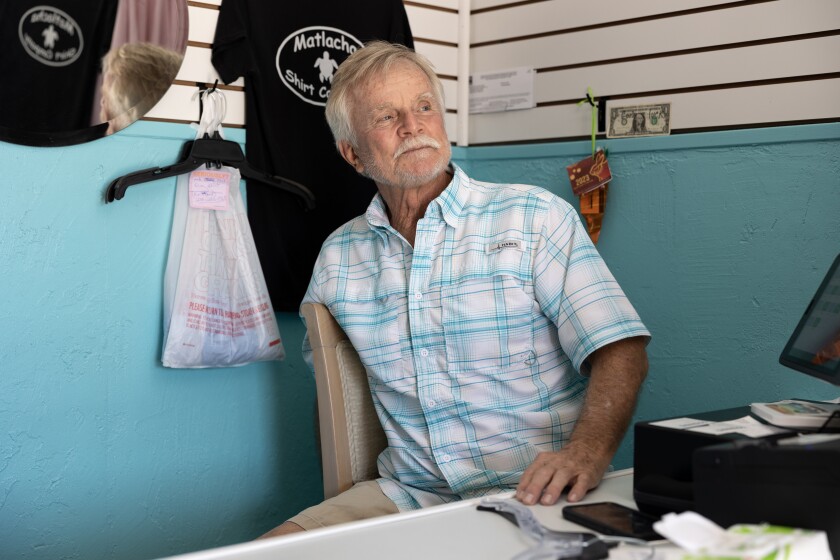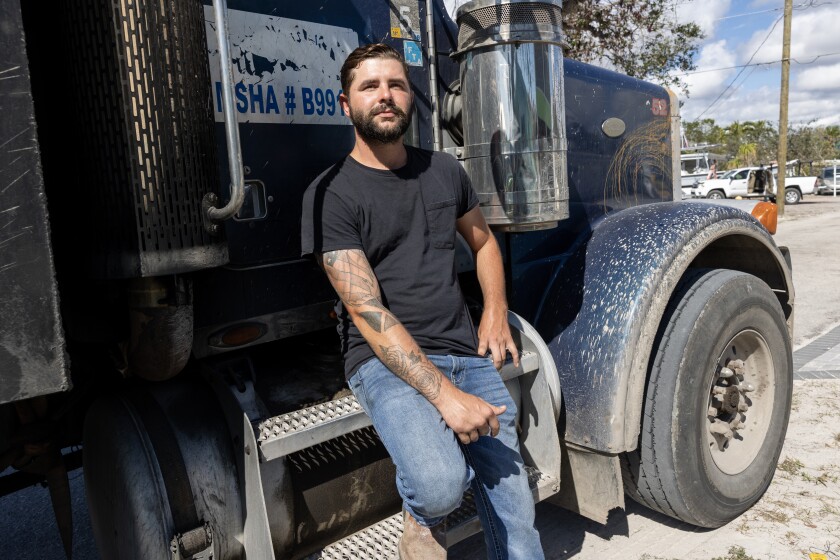Although Cereceda enjoys travel, nothing matches the return to Fort Myers Beach — not just the glint of sunshine on the water, but the community she's enjoyed there. “I’m linked to Fort Myers Beach like it’s an appendage of my body,” she says. “My whole life is wrapped up on that island.”
Hurricane Ian slammed out of the Gulf of Mexico and into Florida with 155-mile winds on Sept. 29 last year. It cut a path of destruction across the width and most of the length of the state before heading further north along the Atlantic coast. The worst effects, however, were felt in Southwest Florida, particularly barrier islands such as Sanibel, Pine Island and Fort Myers Beach, which is as flat as Kansas and only three-eighths of a mile across at its widest point. Lee County, which includes those islands, saw $35 billion worth of damage alone.
It was a life-changing event for everyone who lived there. Fort Myers Beach is marking the anniversary with all manner of events on Friday — prayers and speeches, rum punch toasts and a traditional Hawaiian “paddle out” to a somber sunset remembrance in the water. The first palm trees were planted just this week in Times Square, the devastated beachfront plaza where Cereceda lost two of her businesses. Friday will see the unveiling of a new Times Square Clock meant to symbolize hope and recovery.
Clocks also represent and register the passage of time. A year is a long time, but for a community that took the kind of hit Fort Myers Beach experienced, it’s not nearly long enough for things to resemble anything like normal. After the storm, there was an initial period of relief and gratitude for survival. But soon the community entered into a long stage of uncertainty from which it has yet to emerge. “The one-year mark can be really hard psychologically,” says Bill Veach, a member of the town council. “People feel like they should be farther than they are, which is really hard.”
Fort Myers Beach and its neighbors have received enormous amounts of help from the federal government and the state, along with private charities. Lee County officials spent last month taking public input from residents about how to spend a $1.1 billion housing grant from the Department of Housing and Urban Development (HUD). The county still has to prepare an action plan explaining how it will spend the money. It’s sobering to realize that New York is still dealing with an equivalent HUD grant more than a decade after Superstorm Sandy struck in 2012, says Lee County Commissioner Kevin Ruane.
Ruane heads a long-term planning task force for the county. He’s thinking in terms of where the area needs to be in 10 years, he says, with priorities including hardening water systems and other infrastructure. That kind of time frame has led many people to wonder whether they have the patience and wherewithal to rebuild. Their entire lives, in many cases, were reduced to piles of debris. Some don’t have adequate insurance to recapture what they had, while many retirees have concluded it was just too much to spend two or three years waiting and rebuilding. “I’m 73 — I’m a young buck, right, compared to some people,” says Jim O’Keefe, co-owner of a t-shirt shop in Matlacha, just north of Fort Myers Beach. “If I’m 80 years old, do I want to spend three years rebuilding? And then part of it is the question, are my friends still going to be here.”

Ruane says he was handed a 500-page handbook by officials from the Florida Panhandle. “There’s a peer-to-peer exchange of information that can be very helpful, where they talk about issues they wish they had handled differently or known about before the event,” says Gavin Smith, an expert on disaster response at North Carolina State University. “But within our country, the ability to learn the lessons of one disaster and apply it to another is lacking.”
Caught by Surprise
Hurricane Ian was expected to make landfall further north. Elected officials in Fort Myers Beach and some key staff had decamped to a hotel just off the island, expecting to ride it out and return for a fairly quick cleanup job. Veach says he only packed three shirts and two pair of shorts. Instead, Veach and most of his colleagues found out they’d lost their own houses and cars. “It’s amazing that your whole life gets reduced to a pile of debris that gets hauled off,” Veach said while surveying the damage to a friend’s house on Hibiscus Drive.
The town hall itself was wrecked. It was only demolished about a month ago. The sheriff set up a mobile command center in a trailer while the Baptist church became a hub for people wending their way through the maze of disaster assistance. “We went from search and rescue to housing and feeding,” Ruane says.
Although local needs were suddenly exponentially greater, revenues quickly came under severe pressure. There was no longer such a thing as a working parking meter, while the taxable value of properties plummeted when they’d suddenly turned into vacant lots. Sales taxes spiked thanks to purchases of — well, everything. But in Florida, counties send their collections to the state, which redistributes the money based on a formula that doesn’t take disaster recovery into account. Cash flow mattered because, among other things, while the Federal Emergency Management Agency ultimately reimburses state and local governments for debris removal, they’ve first got to find the money to pay contractors.

Many Florida communities do have thoughtful recovery plans in place, but it’s not a given and it’s something that’s generally lacking in other states. People grow complacent quickly. Twenty or 30 years might pass between disasters, which is more than ample time for collective amnesia to set in — and for institutional memory to have walked out the door. Municipal employees who worked one disaster may have moved on before the next one strikes, and certainly elected officials serve limited terms. “Information sharing happens on an ad hoc basis,” says NC State’s Smith, “but local governments are not trying to learn lessons and codify them.”
Going to the White House
For months after the storm, Fort Myers Beach residents were picking up pieces of glass as big as their fingers. On most of the palm trees, “there wasn’t a lick of green left,” as one resident put it. At a community called Gulf View Colony, most of the manufactured homes had been torn apart by the storm, looking like they’d been bulldozed against trees and into each other.
Just off the island, there was a literal ton of debris resting under the sign for a wrecked restaurant uncomfortably named Hurricane Harry’s. There are still homes being demolished, their pieces hauled away, but for months the roads were filled with trucks pulling enormous black double-trailers that could cart away 10 tons at a time. “This is the most trucks down there I’ve ever seen in a storm,” says Austin White, who drove his 1987 Peterbilt over from Mississippi as soon as Ian hit.
White specialized in clearing out mangrove forests, which turned out to be formidable catchers of windblown wreckage. He led crews of a dozen or more workers who would spend 15 hours a day picking things out of the waterways by hand and putting them on barges. Living on gas station food, White joked that he runs on “Red Bull, hatred and nicotine.” Since every day off meant a few thousand dollars in lost revenue, he took breaks only for Thanksgiving and Christmas. “I hate it happens to people, but it pays me dang good,” he says.
Volunteers wearing yellow t-shirts with hopeful messages such as “when we rebuild” spent the first Sunday in February sweeping up along Estero Boulevard, which runs the seven-mile length of the island. Jacki Liszak, who heads the Fort Myers Beach Chamber of Commerce, was among them. “This is what I do instead of a workout,” she said.

Build Back Better
Disasters can strike anywhere. But notwithstanding the firestorm in Hawaii last month or flooding in California this past winter, Florida is particularly vulnerable due to hurricanes. “The Gulf’s warm waters … attract Atlantic hurricanes like steel to magnets, and then invigorate them,” Jack Davis wrote in his Pulitzer Prize-winning history, The Gulf. Coastal dwellers along the Gulf of Mexico “have to batten down their homes and flee danger more often than any other Americans.”
Despite the risk, the population along the Gulf keeps growing. Lee County’s population grew from 100,000 in 1970 to 800,000 by the time of the storm. No one thinks those numbers are going to shrink as a result of Hurricane Ian. “Somebody who chooses to live in this environment is really deciding to live according to the uncontrollable shifts of Mother Nature,” says Cereceda, the former mayor.
Next month, Cereceda will finish her term as chair of the town's planning and zoning agency. She’ll admit it’s still a mystery what Fort Myers Beach will look like a decade from now. The signature architectural feature of the island — single-story cottages like hers that sit squat on the ground — won’t go away entirely, but will certainly be greatly reduced.

Not everyone can afford such extensive changes. Not everyone had enough insurance to replace what they had; complaints about the stinginess of insurance companies are still a popular local topic of conversation. When he bought his home in Naples, about 20 miles south of Fort Myers Beach, James Guidone took over the flood policy of the previous owner. As it turned out, that policy offered no coverage at all for the contents of his home. And his flood insurance covered about a third of what he needed to rebuild. “We were grossly underinsured for something like this to happen,” Guidone says.
Like residents all over Florida, Guidone has little hope of getting a new, affordable policy now, with major insurance companies pulling out of the state entirely. He’s still working and knows he’s lucky to have the means to “muscle my way through this,” although he won’t be able to retire on the timetable he’d been counting on. A lot of residents, including retirees on fixed incomes, have no chance of making up the difference between what insurance will pay and what rebuilding to code will cost.
Veach, the town councilor, is hoping to persuade the county to devote a sizable chunk of the HUD money to affordable housing in Fort Myers Beach. “We had a mixed-income island, which is one of my favorite things about it,” Veach says. “People from all over the place, all kinds of socio-economic levels, built a lot of little cabins, beach cottages they’d had for 30 or 40 years. If we don't do anything, there's going to probably be a pretty significant gentrification event.”









